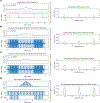Multiphoton simultaneous multislice imaging
- PMID: 38899346
- PMCID: PMC11460106
- DOI: 10.1002/mrm.30148
Multiphoton simultaneous multislice imaging
Abstract
Purpose: To develop multiphoton excitation techniques for simultaneous multislice (SMS) imaging and evaluate their performance and specific absorption rate (SAR) benefit. To improve multiphoton SMS reconstruction quality with a novel CAIPIRINHA (controlled aliasing in parallel imaging results in higher acceleration) design.
Theory and methods: When a conventional single-slice RF field is applied together with an oscillating gradient field, the two can combine to generate multiphoton excitation at multiple discrete spatial locations. Because the conventional RF is reused at multiple spatial locations, multiphoton excitation offers reduced SAR for SMS applications. CAIPIRINHA shifts are often used to improve parallel-imaging acceleration. Interestingly, CAIPIRINHA-type shifts can be obtained for multiphoton SMS by updating the oscillating gradient phase at every phase encode. In this work, both a gradient-echo and a spin-echo sequence with multiphoton CAIPIRINHA-SMS excitation pulses are implemented for in vivo human imaging at 3 T.
Results: For three slices, multiphoton SMS provides a 51% reduction in SAR compared with conventional superposition SMS, whereas for five slices, SAR is reduced by 66%. Multiphoton SMS outperforms PINS (power independent of number of slices) and MultiPINS in terms of SAR reduction especially when the pulse duration is short, slices are thin, and/or the slice spacing is large. A custom CAIPIRINHA phase-encoding design for multiphoton SMS significantly improves reconstruction quality.
Conclusion: Multiphoton SMS excitation can be obtained by combining conventional single-slice RF pulses with an oscillating gradient and offers significant SAR benefits compared with conventional superposition SMS. A novel CAIPIRINHA design allows higher multiband factors for multiphoton SMS imaging.
Keywords: CAIPIRINHA; MultiPINS; PINS; SAR; SMS; multiphoton.
© 2024 The Authors. Magnetic Resonance in Medicine published by Wiley Periodicals LLC on behalf of International Society for Magnetic Resonance in Medicine.
Conflict of interest statement
Conflicts of Interest
CL and VH are inventors of patent Application US17/664,799 related to multiphoton MRI.
Figures









References
-
- Abragam A. The Principles of Nuclear Magnetism. Repr. Clarendon Pr; 1986.
-
- Michal CA. Nuclear magnetic resonance noise spectroscopy using two-photon excitation. J Chem Phys. 2003;118(8):3451–3454. doi: 10.1063/1.1553758 - DOI
-
- Brunner DO, Pavan M, Dietrich BE, Rothmund D, Heller A, Prüssmann KP. Sideband Excitation for Concurrent RF Transmission and Reception. In Proceedings of the 19th Annual Meeting of ISMRM, Montreal, Canada, 2011. Abstract 0625.
MeSH terms
Grants and funding
LinkOut - more resources
Full Text Sources
Medical
Miscellaneous

